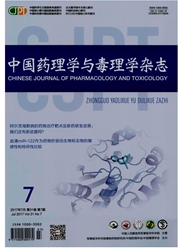

 中文摘要:
中文摘要:
目的观察孕期摄食限制(PFR)所致雄性子代鼠海马结构及功能损伤改变,并探讨其发生机制。方法健康Wistar雌性大鼠受孕后第11~20天(GD11~GD20)限食,给予正常对照组日均摄食量的50%,部分孕鼠于GD20麻醉处死取胎鼠;其余孕鼠自然生产所得雄性子代鼠断奶后给予高脂饮食喂养,一批于生后17周龄(PW17)麻醉处死,另一批从PW17起,21 d内给予慢性不可预知性刺激(UCS)后,于PW20处死,取海马组织。采用HE染色和(或)透射电镜进行组织学观察,ELISA试剂盒检测胎鼠血皮质酮水平,PCR检测海马糖皮质激素受体(Gr)、脑源性神经营养因子(Bdnf)通路、突触可塑性相关基因的mRNA表达。结果与正常对照组相比,PFR胎鼠海马显示亚细胞水平病理损伤,胎血皮质酮水平增加了1.19倍(P〈0.05),Gr mRNA表达升高了38%(P〈0.05),Bdnf、N-甲基-D-天冬氨酸受体亚单位1(Nr1)、Nr2B和突触蛋白Ⅰ的mRNA表达分别降低了25.0%,16.1%,16.1%和17.6%(P〈0.05)。与高脂对照组相比,PFR成年子代鼠海马仅显示轻微病理改变,而PFR成年子代鼠在UCS后,海马病理损伤明显,表现为锥体细胞层极薄,细胞间隙增大,细胞数目减少和核皱缩,同时海马c AMP应答元件结合蛋白、Bdnf、酪氨酸激酶受体及Nr1 mRNA表达分别显著降低了51.0%,50.0%,52.0%和33.3%(P〈0.05,P〈0.01)。结论 PFR可致雄性子代鼠海马结构及功能损伤,其机制可能与PFR所致的母源性高GC引起子代鼠海马Bdnf通路抑制有关。
 英文摘要:
英文摘要:
OBJECTIVE To observe hippocampal structure and function alterations in male offspring rats with prenatal food restriction (PFR) and elucidate the underlying mechanism. METHODS Maternal rats were fed 50% of the daily food intake of control group from gestational day (GD) 11 until GD20. Half of the pregnant rats were sacrificed and male fetal rats were obtained to collect the hippo- campus and blood. Other pregnant rats went through full-term delivery and all pups were fed a high-fat diet (HFD) after weaning. Some of the male adult offspring were sacrificed at postnatal weeks (PW) 17, while others were exposed to unpredictable chronic stress (UCS) for 21 d since PW17 and then sacrificed. The hippocampus of both types of offspring rats was collected. The pathological changes of the hippocampus were analyzed under a hematoxylin-eosin staining and transmission electron micro- scope, enzyme-linked immunosorbent assay kit was used to detect the level of blood corticosterone, multiplex polymerase chain reaction (PCR) was performed to detect the mRNA expressions of genes in fetal hippocampus, while real-time quantitative PCR was performed to detect the mRNA expression of genes in adult offspring's hippocampus. RESULTS PFR not only caused ultrastructure injury to hipp- ocampal neurons, but also increased serum corticosterone level to 2.19 times that of the normal control group in male fetal rats (P〈0.05), accompanied by the enhancement of the hippocampal expression of glucocorticoid receptor to 1.38 times that of the normal control group ( P〈0.05), while the expression of brain-derived neurotrophic factor (Bdnf), N-methyl D-aspartate 1 receptor subunit 1 ( Nrl), Nr2B and synapsin I decreased by 25.0%, 16.1%, 16.1% and 17.6% in comparison with the normal control group (P〈0.05), respectively. Moreover, compared with the HFD control, the offspring rats of PFR+HFD group exhibited slight histological changes in the CA1 and dentate gyrus area in the hippocampus. How- ever, af
 同期刊论文项目
同期刊论文项目
 同项目期刊论文
同项目期刊论文
 The fetal original of high sensitivity of hypothalamic-pituitary-adrenal axis in female offspring ra
The fetal original of high sensitivity of hypothalamic-pituitary-adrenal axis in female offspring ra 期刊信息
期刊信息
